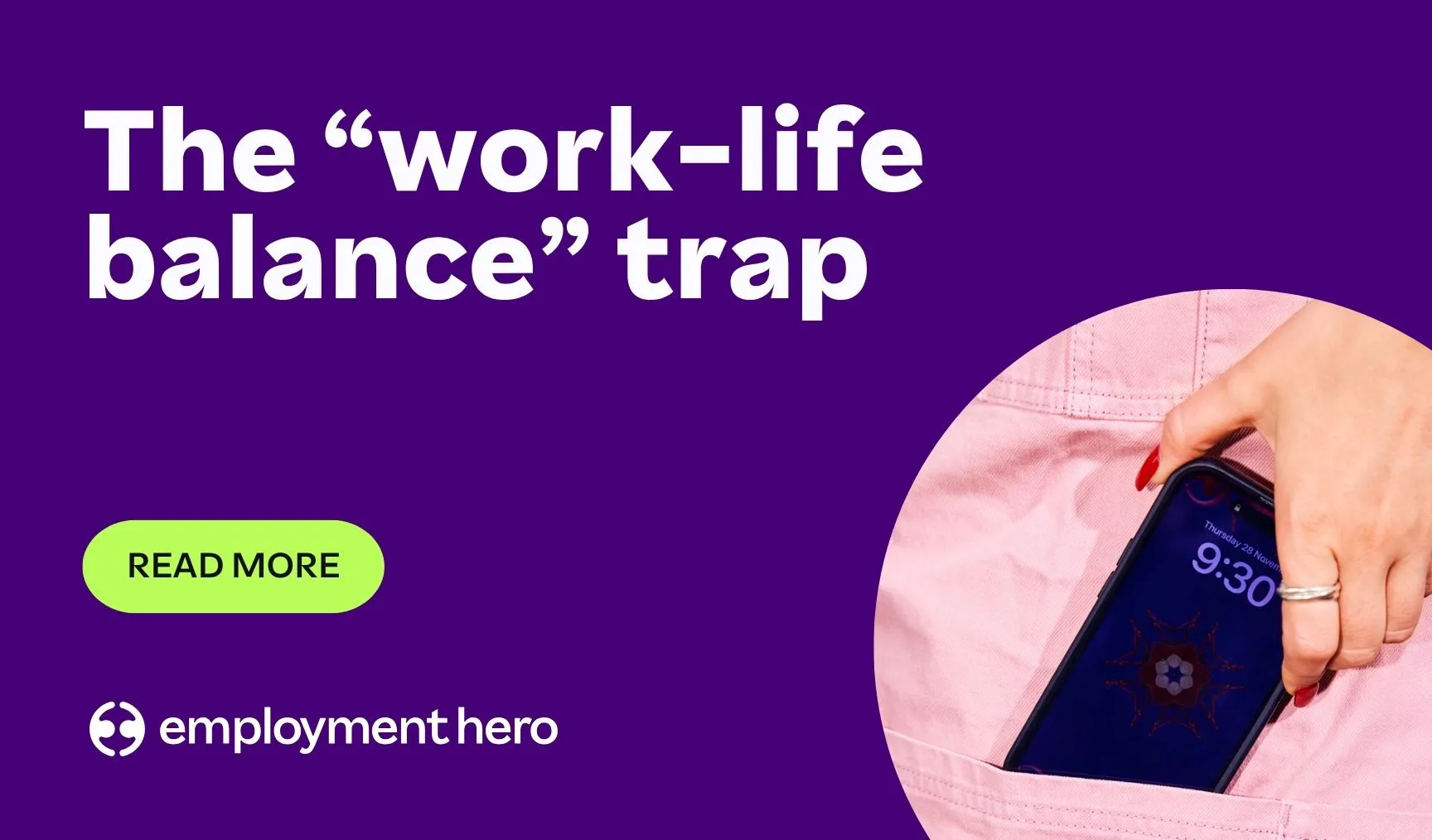New Paid Family and Domestic Violence Leave in Australia
Australia has just introduced changes to paid family and domestic violence leave. Find out what it means for your business.

In late 2022, the Fair Work Amendment (Paid Family and Domestic Violence Leave) Bill 2022 was introduced into parliament, and it’s important you’re prepared for the changes coming your way.
2023 is set to be a big year for employment law changes, with new paid family and domestic violence leave in Australia to be one of the first to come into effect.
The change will be introduced in two different stages of the year, depending on the company size beginning 1 February 2023. By 1 August 2023, all employees will be entitled to ten days of paid family and domestic violence leave per year, including casuals. We’ll break down everything you need to know about this change below.
Disclaimer: The information in this article is relevant as at 11 Jan 2023, and has been prepared by Employment Hero Pty Ltd ABN (11 160 047 709) (Employment Hero). The views expressed herein are general information only and are provided in good faith to assist employers and their employees. The Information is based on data supplied by third parties. While such data is believed to be accurate, it has not been independently verified and no warranties are given that it is complete, accurate, up to date or fit for the purpose for which it is required. Employment Hero does not accept responsibility for any inaccuracy in such data and is not liable for any loss or damages arising either directly or indirectly as a result of reliance on, use of or inability to use any information provided in this article.
What is the Paid Family and Domestic Violence Leave Bill 2022?
All employees are entitled to the 11 National Employment Standards under the Fair Work Act. These cover the minimum entitlements that employers are required to give their employees, and cover areas relating to leave entitlements, flexible working arrangements, working hours and more.
Now, under the Fair Work Amendment (Paid Family and Domestic Violence Leave) Bill 2022, all employees in the Fair Work system who are experiencing family or domestic violence, or those supporting family and household members, will be able to access ten days of paid family and domestic violence leave in a 12-month period.
How is it different from the current family and domestic violence leave entitlements?
In 2018, it was recognised that employees who experience family and domestic violence needed to be supported better. This led to five days of unpaid family and domestic violence leave being introduced under the National Employment Standards.
In 2021, it was reviewed and the Government made the decision to increase the amount of leave to ten days for employees on Modern Awards. With a change of government, this prompted the newly elected ALP to review the entitlements and further expand who was able to access this leave.
With the amendment, the following changes will occur:
- All employees (including casual employees) will be able to access ten days paid leave per year.
- The full ten days will be available upfront on commencement of employment, however unused leave will not carry over each year.
- The definition of “Family and Domestic Violence” will now include behaviour by a current or previous intimate partner of an employee, or member of the employee’s household.
Who is eligible for the new paid family and domestic violence leave?
Full time, part time and casual employees are eligible. However, when they are eligible depends on the size of their current employer as outlined below.
When can employees access these leave entitlements?
Paid family and domestic violence leave will be available from two different dates, depending on the size of the business. It applies to full time, part time and casual employees and will not accumulate over the years if it’s not used. Employees will also be entitled to the ten days upfront, i.e. they will not have to accumulate it.
From 1 February 2023, employees who work in businesses with 15 or more employees will be able to access paid family and domestic violence leave.
From 1 August 2023, employees who work in businesses with less than 15 employees will be able to access paid family and domestic violence leave.
If an employee is already working for their employer when the leave becomes available, then the entitlement will renew on their work anniversary date. It will not renew on the day the leave became available (i.e. 1 February 2023 or 1 August 2023).
What is family and domestic violence?
Family and domestic violence is violent, threatening or other abusive behaviour by a close relative of an employee, a member of an employee’s household, or a current or former intimate partner of an employee, that seeks to coerce or control the employee and causes the employee harm or to be fearful. Such behaviour can include:
- Physical violence
- Sexual assault or abuse
- Verbal abuse
- Psychological or emotional abuse
- Financial abuse
- Stalking
- Spiritual or cultural abuse
- Abuse or threatened abuse of pets
- Damage to property or personal belongings
- Technology assisted abuse
- Serious neglect where there is a relationship of dependence
- Behaviour by a person using violence that causes a child to be exposed to the effects of family and domestic violence
What can you do as an employer if you suspect an employee is currently experiencing family and domestic violence?
The reality is that those experiencing family and domestic violence are in a stressful situation, and it often flows through to increased financial stress, feelings of isolation and vulnerability. It’s also likely that they may feel shame for the situation they’re currently in.
As an employer, giving support is one of the best ways to help an employee going through this – not to mention that it’s part of your obligations as an employer around health and safety.
The first thing you should do is to start a conversation. Let them know that you’re here for them, and there’s a new paid entitlement they can access. You can also consider putting additional safety screening in place such as monitoring incoming calls, changing their work phone numbers or email addresses. You could also allow them to work from another location or working hours, and encourage flexible working arrangements. For more information on how flexible working arrangements can benefit your employees, read more on our blog here.
If they need additional time off beyond the ten days of leave, let them know that they can access annual leave or unpaid leave. After that, provide them with a list of services and phone numbers they can reach out to for help and support services.
And lastly, ensure that all conversations are kept strictly confidential.
You should also be aware that as an employer, you may ask an employee for evidence that shows they took the leave to deal with family and domestic violence. The evidence should satisfy a reasonable person that the employee took the leave to deal with the impact of family and domestic violence.
Some examples of evidence may include documents issued by the court or police, family violence support service documents or statutory declarations. If the employee fails to provide the requested evidence, they may not get the family and domestic violence leave.
Be aware of the new pay slip requirements
From 1 February 2023, the way family and domestic violence leave is recorded on pay slips will change. The aim of this change is to reduce any additional risk to the employee’s safety.
Employers must keep records of the leave taken for their own records. However, they must show no signs of family and domestic leave being taken on payslips.
For more information on the changes to pay slips, visit fairwork.gov.au.
How do employers get prepared for the change?
To start getting ready you should update current leave policies to include the new entitlement and adjust your payroll system to ensure it meets the new pay slip requirements. You can also download a comprehensive leave policy template to help you get started. You might also want to create a workplace response to family and domestic violence, as well as create additional resources such as a helpline poster or organise education sessions. To learn more about related legislative changes, check out our guide on understanding the Secure Jobs, Better Pay Bill. Additionally, understanding the broader context of employee leave, including parental leave, is essential for employers.
Providing support to employees experiencing family and domestic violence
Providing support to employees who are currently experiencing any abusive behaviour is essential to helping them navigate this difficult time.
If you or someone you know is in immediate danger, call 000 and ask for ambulance or police services. You can also seek help via a family violence counselling service below.
- 1800RESPECT – 1800 737 732
- Men’s Referral Service – 1300 766 491
- Mensline Australia – 1300 789 978
- Lifeline – 13 11 14
- Kids Helpline – 1800 551 800
- Elder Abuse Helpline – 1800 353 374
- Beyond Blue – 1300 22 4636
For more information about paid family and domestic violence leave, visit fairwork.gov.au.
Stay across changes to employment law updates
Staying up to date on employment is challenging – it’s constantly changing and it’s critical to stay on top of it all. We’ve created this factsheet that will help you understand changes that business owners need to know. If you’d like to access more information on employee wellbeing, take a look at our employee wellbeing survey template, psychological safety survey template or our wellness at work report.
Related Resources
-
 Read more: From hiring mismatch to SmartMatch: 5 critical things your recruitment strategy is missing
Read more: From hiring mismatch to SmartMatch: 5 critical things your recruitment strategy is missingFrom hiring mismatch to SmartMatch: 5 critical things your recruitment strategy is missing
We’ve wrapped up five critical things your recruitment strategy might be missing so you can feel confident in your hiring…
-
 Read more: Product Update: June 2025
Read more: Product Update: June 2025Product Update: June 2025
Follow our June 2025 product update as we share all of the latest and greatest features we’ve released over the…
-
 Read more: The ‘work-life balance’ trap: Why promising it is hurting your SME recruitment (and what to promise instead)
Read more: The ‘work-life balance’ trap: Why promising it is hurting your SME recruitment (and what to promise instead)The ‘work-life balance’ trap: Why promising it is hurting your SME recruitment (and what to promise instead)
For growing SMEs, work-life integration is a sustainable way to support your team and attract top talent. Explore how your…





















